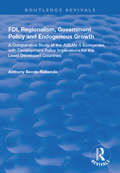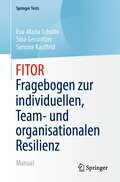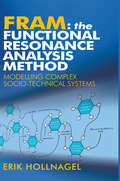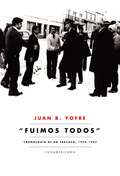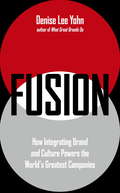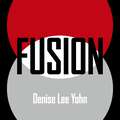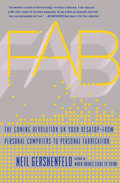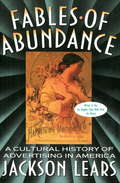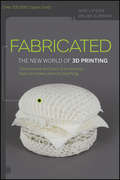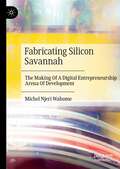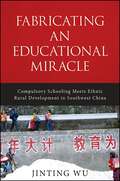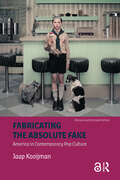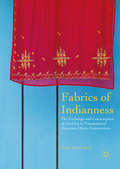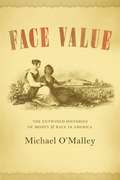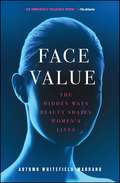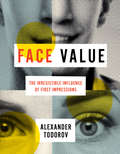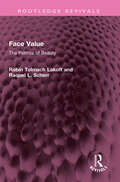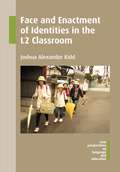- Table View
- List View
FDI, Regionalism, Government Policy and Endogenous Growth: A Comparative Study of the ASEAN-5 Economies, with Development Policy Implications for the Least Developed Countries
by Anthony Bende-NabendePublished in 1999, this text investigates whether FDI caused spill over effects which have led to the economic growth of the ASEAN-5 economies, and if that it so, whether the ASEAN Preferential Trade Agreement (APTA) had a significant effect in attracting FDI to the region. It takes into account the different levels of economic development of the countries under analysis. The results from the structural (static) model suggest that FDI has stimulated economic growth through the human factors followed by technology transfer, international trade, and learning by doing, and that the formation of APTA had a lagged influence on FDI inflows into the advantage of the more developed member countries and the disadvantage of the less developed countries. Those from the multiplier (dynamic) effects analysis demonstrate that whereas the impact is immediate in the more developed, politically stable and foreign investment friendly economies, there is a time lag in those economies which are less developed and more hostile to FDI. The analysis presents an empirical comparison of how the level of economic development affects the interaction of FDI, regionalism and economic growth.
FITOR - Fragebogen zur individuellen, Team und organisationalen Resilienz: Manual (SpringerTests)
by Simone Kauffeld Eva-Maria Schulte Sina GessnitzerFITOR (Fragebogen zur individuellen, Team und organisationalen Resilienz): Dieser Fragebogen erfasst die Resilienz – das Vermögen, Misserfolge, Rückschläge oder andere potentiell bedrohliche Situationen erfolgreich zu überwinden – auf Ebene des Individuums-, des Teams- und der Organisation. Autoren: Dr. Eva-Maria Schulte, Dr. Sina Gessnitzer, Prof. Dr. Simone Kauffeld Die internen Konsistenzen der reduzierten Skala lagen sowohl für die individuelle Ebene (Studie 1: α = 0,84; Studie 2: α = 0,82), als auch für die Team- (Studie 1: α = 0,93; Studie 2: α = 0,94.) und die organisationale Ebene (Studie 1: α = 0,92; Studie 2: α = 0,92) im guten bis sehr guten Bereich (Kline 1999). Konvergente Validierung anhand unterschiedlicher Skalen je Ebene z.B. Validierungsskalen der individuellen Ebene: Individuelle Selbstwirksamkeit Validierungsskalen der Teamebene: Selbstwirksamkeit im Team Validierungsskalen der organisationalen Ebene: Organisationsklima Da der FITOR auf drei Ebenen (Individuum, Team, Unternehmen) ausgewertet werden kann, müssen wir uns hier mit den Autorinnen kurzschließen, aber die sind ja in direkter Nähe… ich würde es als Gruppenverfahren ähnlich wie den SPA sehen: Mindestanzahl Teilnehmende bevor ich Ergebnisse sehen kann. Die Individual- und Teamitems könnten als Mittelwerte pro Team ausgewertet werden. Um ein sinnvolles Ergebnis für ein ganzes Unternehmen zu bekommen, könnte eine Funktion zum Aggregieren mehrerer Gruppenergebnisse implementiert werden. Allerdings ist hier auch die Frage, ob ich die Unternehmensitems auch aus Sicht des Teams als Mittelwert nutzen kann – „Was denkt das Team über die Unternehmens-Reslizienz“? Wenn das möglich ist, wäre es vermutlich ein „reines“ Standardverfahren analog zum SPA. Weitere Möglichkeiten ohne eine konkrete technische Umsetzung im Kopf zu haben: Die Teilnehmenden bekommen nach dem Ausfüllen einen Individual-Report als PDF zugeschickt (bzw. angezeigt, wenn sie keine Mail Adresse haben). So hätten wir auch eine individuelle Auswertung, ohne dass eine Führungskraft Einzelergebnisse sieht.
FRAM: Modelling Complex Socio-technical Systems
by Erik HollnagelResilience engineering has consistently argued that safety is more than the absence of failures. Since the first book was published in 2006, several book chapters and papers have demonstrated the advantage in going behind 'human error' and beyond the failure concept, just as a number of serious accidents have accentuated the need for it. But there has not yet been a comprehensive method for doing so; the Functional Resonance Analysis Method (FRAM) fulfils that need. Whereas commonly used methods explain events by interpreting them in terms of an already existing model, the FRAM is used to model the functions that are needed for everyday performance to succeed. This model can then be used to explain specific events, by showing how functions can be coupled and how the variability of everyday performance sometimes may lead to unexpected and out-of-scale outcomes - either good or bad. The FRAM is based on four principles: equivalence of failures and successes, approximate adjustments, emergence, and functional resonance. As the FRAM is a method rather than a model, it makes no assumptions about how the system under investigation is structured or organised, nor about possible causes and cause-effect relations. Instead of looking for failures and malfunctions, the FRAM explains outcomes in terms of how functions become coupled and how everyday performance variability may resonate. This book presents a detailed and tested method that can be used to model how complex and dynamic socio-technical systems work, to understand why things sometimes go wrong but also why they normally succeed.
FUIMOS TODOS (EBOOK)
by Juan B. Yofre"Nadie fue", el libro anterior de Juan B. Yofre, se convirtió en una de las grandes sorpresas editoriales de los últimos años. Sobre la base de fuentes privilegiadas, narraba el desarrollo histórico de la Argentina de los años 70 hasta la caída de Isabel Perón. Fuimos todos es la fascinante continuación de aquel éxito: retoma los avatares de nuestra historia desde el 24 de marzo de 1976 hasta la aventura militar de Malvinas -que llevó al fin del Proceso- y sus consecuencias. Yofre repite aquí su procedimiento periodístico, exhuma documentos, apuntes, informes, cartas, que ven la luz por primera vez. Hallazgos que muestran aspectos absolutamente desconocidos de un período de violencia y dan cuenta del enfrentamiento entre los argentinos, ya no solamente de las Fuerzas Armadas y las organizaciones terroristas sino también de las continuas luchas intestinas del propio régimen castrense. Un eslabón más en la historia de la decadencia política argentina. Exhaustivamente documentado, polémico, revelador, Fuimos todos expone los hechos, como dice el autor, "sine ira et cum studio", es decir, para que el lector saque sus propias conclusiones y con la honesta intención de evitar que se repitan los nefastos errores del pasado reciente. El teniente general Jorge Rafael Videla asumió la presidencia de la Nación el 29 de marzo de 1976, luego de deponer cinco días antes a la presidenta constitucional María Estela Martínez Cartas de Perón, más conocida por su nombre artístico de "Isabel". Al poco tiempo, Videla comenzó a realizar visitas a ciudades del interior. La foto lo muestra durante un viaje a la austral ciudad de Ushuaia, Tierra del Fuego, en el invierno de 1976. Como evidencia la instantánea, a pesar del rigor climático la gente se acercaba a saludarlo. Es más, si se pone la atención se verá que un hombre salió de un lugar cerrado, sólo con un suéter, para estrechar su mano. Es una foto atípica que muestra en pequeña escala el grado de aquiescencia del que gozó el gobierno del Proceso militar en sus primeros años de gran parte de la ciudadanía. Dos años más tarde, Videla debería salir al balcón de la Casa de Gobierno para saludar a la multitud que festejaba la victoria del Campeonato Mundial de Fútbol de 1978. Y lo mismo ocurrió en septiembre de 1979, cuando la selección juvenil de fútbol se consagró campeona mundial en Japón. Esta foto fue elegida por lo escasamente conocida. Y porque exhibe a un Videla en el que no aparecen rodeándolo custodias ni agentes de seguridad. Sólo simples ciudadanos con interés en saludar a su presidente.
FUSION: How Integrating Brand and Culture Powers the World's Greatest Companies
by Denise Lee Yohn'Leaders everywhere are trying to build great brands, but few realise how powerfully brands are shaped by the cultures of their organizations. This compelling book shows how.' -Adam Grant, New York Times bestselling author of Originals and Give and TakeIn FUSION, Denise Lee Yohn examines some of the world's greatest organizations and reverse-engineers their greatness - specifically how they've integrated what's on the inside (culture) with what's on the outside (brand) for remarkable results. Through detailed case studies, interviews with industry leaders, findings from respected academic research and drawing on her own experience working with extraordinary brands across a broad range of sectors, Denise shows how great companies achieve the brand-culture fusion that creates extraordinary results and growth. FUSION is for those with responsibility and oversight for the core operations of their business (C-Suite and line managers) who also set the tone and direction for their companies. The book includes access to Denise's proprietary online assessment for determining how close to or how far from brand/culture integration a company is and a blueprint for achieving brand-culture fusion.
FUSION: How Integrating Brand and Culture Powers the World's Greatest Companies
by Denise Lee Yohn'Leaders everywhere are trying to build great brands, but few realise how powerfully brands are shaped by the cultures of their organizations. This compelling book shows how.' -Adam Grant, New York Times bestselling author of Originals and Give and TakeIn FUSION, Denise Lee Yohn examines some of the world's greatest organizations and reverse-engineers their greatness - specifically how they've integrated what's on the inside (culture) with what's on the outside (brand) for remarkable results. Through detailed case studies, interviews with industry leaders, findings from respected academic research and drawing on her own experience working with extraordinary brands across a broad range of sectors, Denise shows how great companies achieve the brand-culture fusion that creates extraordinary results and growth. FUSION is for those with responsibility and oversight for the core operations of their business (C-Suite and line managers) who also set the tone and direction for their companies. The book includes access to Denise's proprietary online assessment for determining how close to or how far from brand/culture integration a company is and a blueprint for achieving brand-culture fusion.(P)2018 Hodder & Stoughton Limited
Fab: The Coming Revolution on Your Desktop--from Personal Computers to Personal Fabrication
by Neil GershenfeldWhat if you could someday put the manufacturing power of an automobile plant on your desktop? According to Neil Gershenfeld, the renowned MIT scientist and inventor, the next big thing is personal fabrication-the ability to design and produce your own products, in your own home, with a machine that combines consumer electronics and industrial tools. Personal fabricators are about to revolutionize the world just as personal computers did a generation ago, and Fab shows us how.
Fables Of Abundance: A Cultural History Of Advertising In America
by Jackson LearsFables of Abundance ranges from the traveling peddlers of early modern Europe to the twentieth-century American corporation, exploring the ways that advertising collaborated with other cultural institutions to produce the dominant aspirations and anxieties in the modern United States.
Fabricated
by Hod Lipson Melba KurmanFabricated tells the story of 3D printers, humble manufacturing machines that are bursting out of the factory and into schools, kitchens, hospitals, even onto the fashion catwalk. Fabricated describes our emerging world of printable products, where people design and 3D print their own creations as easily as they edit an online document.A 3D printer transforms digital information into a physical object by carrying out instructions from an electronic design file, or 'blueprint.' Guided by a design file, a 3D printer lays down layer after layer of a raw material to 'print' out an object. That's not the whole story, however. The magic happens when you plug a 3D printer into today's mind-boggling digital technologies. Add to that the Internet, tiny, low cost electronic circuitry, radical advances in materials science and biotech and voila! The result is an explosion of technological and social innovation.Fabricated takes the reader onto a rich and fulfilling journey that explores how 3D printing is poised to impact nearly every part of our lives.Aimed at people who enjoy books on business strategy, popular science and novel technology, Fabricated will provide readers with practical and imaginative insights to the question 'how will this technology change my life?' Based on hundreds of hours of research and dozens of interviews with experts from a broad range of industries, Fabricated offers readers an informative, engaging and fast-paced introduction to 3D printing now and in the future.
Fabricating Silicon Savannah: The Making Of A Digital Entrepreneurship Arena Of Development
by Michel Njeri WahomeThis book provides a comprehensive overview of technology start-up arenas in Nairobi and examines their global place. These start-ups are popularly perceived as representing future prosperity that is incorporated in the present. The author examines how developing country arenas lay bare the power asymmetries and taken-for-granted assumptions that determine which technoscientific imaginaries become globalized and universal, and are supported by legitimizing narratives, logics and institutions. A framing of ‘catch-up’ or ‘leapfrogging’ for technoscientific development that is based on capitalist modernity is regarded as incontrovertible—so much so that alternative values and approaches to technology production are rarely contemplated. This book documents how actors in Nairobi’s startup arena relate to these imaginaries and the affects, enactments and places that they produce.
Fabricating an Educational Miracle: Compulsory Schooling Meets Ethnic Rural Development in Southwest China
by Jinting WuWinner of the 2017 American Educational Research Association's Division B Outstanding Book Recognition AwardWinner of the 2017 Society of Professors of Education Outstanding Book AwardIn today's China, education is translated into both acute social desires and profound disenchantment. Shanghai's stellar performance in the recent Program for International Student Assessment paints a celebratory image of educational success yet tells only a partial story. For many in rural China who are schooled yet prepared only for factory sweatshops, education remains an elusive ideal and offers a hollowed promise of social mobility. Fabricating an Educational Miracle laces together complex accounts of how compulsory education produces dilemmas and possibilities in village schools in Southwest China. Drawing from interviews, participant observations, oral history, and archival research in a Miao and a Dong village-town in Qiandongnan Prefecture, Guizhou Province, this book examines the manifold and contradictory agendas that have captured rural ethnic schooling at a crossroads.
Fabricating the Absolute Fake - Revised Edition (American Studies)
by Jaap KooijmanWhen rock star Bono told Oprah Winfrey that America is an ideal that is supposed to be contagious, the talk show host was moved to tears. Such an imagined America, rather than the nation-state USA, is the topic of Fabricating the Absolute Fake. Pop and politics become intertwined, as Hollywood, television, and celebrities spread the American Dream around the world. Using concepts such as the absolute fake and karaoke Americanism, the book examines this global mediation as well as the way America is appropriated in pop culture produced outside of the USA, as demonstrated by such diverse cultural icons as the Elvis-inspired crooner Lee Towers and the Moroccan-Dutch rapper Ali B. This revised and extended edition includes a new chapter on Barack Obama and Michael Jackson as global celebrities and a new afterword on teaching American pop culture.
Fabrics of Indianness
by Sinah Theres KloßThis book describes how Guyanese Hindus recreate Indian ethnic identity in contemporary Guyana and examines how Hindu traditions have been transformed in this multi-religious and multi-ethnic society. By illustrating the exchange and consumption of clothing, the book demonstrates that the practices of wearing and gifting clothes materialize and visualize relationships. The significant outward migration of Guyanese to North America has resulted in substantial international gift exchange and transnational rituals. Applying the concept of translocality, this book demonstrates that different localities continue to influence transnational networks and socio-cultural practices. It provides a study of migration that emphasizes various aspects of material and visual closeness, conceptualizing the notion of touch.
Face Value: The Entwined Histories of Money and Race in America
by Michael O'MalleyFrom colonial history to the present, Americans have passionately, even violently, debated the nature and the character of money. They have painted it and sung songs about it, organized political parties around it, and imprinted it with the name of God--all the while wondering: is money a symbol of the value of human work and creativity, or a symbol of some natural, intrinsic value? In Face Value, Michael O'Malley provides a deep history and a penetrating analysis of American thinking about money and the ways that this ambivalence unexpectedly intertwines with race. Like race, money is bound up in questions of identity and worth, each a kind of shorthand for the different values of two similar things. O'Malley illuminates how these two socially constructed hierarchies are deeply rooted in American anxieties about authenticity and difference. In this compelling work of cultural history, O'Malley interprets a stunning array of historical sources to evaluate the comingling of ideas about monetary value and social distinctions. More than just a history, Face Value offers us a new way of thinking about the present culture of coded racism, gold fetishism, and economic uncertainty.
Face Value: The Hidden Ways Beauty Shapes Women's Lives
by Autumn Whitefield-MadranoA thought-provoking examination of how we think and talk about beauty today--and the unexpected and often positive ways that beauty shapes our lives.For decades, we've discussed our insecurities in the face of idealized, retouched, impossibly perfect images. We've worried primping and preening are a distraction and a trap. But have we focused too much on beauty's negative influence? In Face Value, journalist Autumn Whitefield-Madrano thoughtfully examines the relationship between appearance and science, social media, sex, friendship, language, and advertising to show how beauty actually affects us day to day. Through meticulous research and interviews with dozens of women across all walks of life, she reveals surprising findings, like that wearing makeup can actually relax you, that you can convince people you're better looking just by tweaking your personality, and the ways beauty can be a powerful tool of connection among women. Equal parts social commentary, cultural analysis, careful investigation, and powerful personal anecdotes, Face Value is provocative and empowering--and a great conversation starter for women everywhere.
Face Value: The Irresistible Influence of First Impressions
by Alexander TodorovThe scientific story of first impressions—and why the snap character judgments we make from faces are irresistible but usually incorrectWe make up our minds about others after seeing their faces for a fraction of a second—and these snap judgments predict all kinds of important decisions. For example, politicians who simply look more competent are more likely to win elections. Yet the character judgments we make from faces are as inaccurate as they are irresistible; in most situations, we would guess more accurately if we ignored faces. So why do we put so much stock in these widely shared impressions? What is their purpose if they are completely unreliable? In this book, Alexander Todorov, one of the world's leading researchers on the subject, answers these questions as he tells the story of the modern science of first impressions.Drawing on psychology, cognitive science, neuroscience, computer science, and other fields, this accessible and richly illustrated book describes cutting-edge research and puts it in the context of the history of efforts to read personality from faces. Todorov describes how we have evolved the ability to read basic social signals and momentary emotional states from faces, using a network of brain regions dedicated to the processing of faces. Yet contrary to the nineteenth-century pseudoscience of physiognomy and even some of today's psychologists, faces don't provide us a map to the personalities of others. Rather, the impressions we draw from faces reveal a map of our own biases and stereotypes.A fascinating scientific account of first impressions, Face Value explains why we pay so much attention to faces, why they lead us astray, and what our judgments actually tell us.
Face Value: The Politics of Beauty (Routledge Revivals)
by Robin Lakoff Raquel ScherrFirst published in 1984, Face Value confronts the pervasive power of beauty through art and literature, as well as interviews with men and women with varying perspectives on the subject. The topics covered range widely: the history of beauty from the Greeks to the present; the pathology of beauty: how women have been willing to harm themselves, mentally and physically, to achieve ‘beauty’; the language we use to speak of beauty, and its implications; our attitudes towards beauty, as examined by psychologists; beauty and ethnic identity; men and beauty. The authors present in fact a redefinition of beauty, enabling both women and men to enjoy it in themselves and in others, while discarding the sex-role stereotypes that have governed the definition of beauty in the past. With a new preface that explores the gaps created by time in the book’s discourse, this book will be of interest to students of linguistics, gender studies, women’s studies, cultural studies, sociology and anthropology.
Face and Enactment of Identities in the L2 Classroom
by Joshua Alexander KiddThis book examines student identities as revealed through the pragmatics of face as observed in the context of English L2 classroom interaction between Japanese students and a native speaker teacher. Classroom recordings together with retrospective interviews reveal specific points during learning activities when the students and their teacher s interpretations of classroom communication deviate from what was intended. This research study is a potent reminder that what students and teachers may consider as standard and conventionally acceptable language use and behaviour within the classroom context can differ dramatically according to social, cultural and individual frames of reference. The book outlines an innovative teacher professional development program which encourages teachers to reflect on and, where desired, modify or discontinue existing pedagogic practices. "
Face-to-Face Communication over the Internet
by Arvid Kappas Nicole C. KrämerSocial platforms such as MySpace, Facebook and Twitter have rekindled the initial excitement of cyberspace. Text-based, computer-mediated communication has been enriched with face-to-face communication such as Skype, as users move from desktops to laptops with integrated cameras and related hardware. Age, gender and culture barriers seem to have crumbled and disappeared as the user base widens dramatically. Other than simple statistics relating to e-mail usage, chatrooms and blog subscriptions, we know surprisingly little about the rapid changes taking place. This book assembles leading researchers on nonverbal communication, emotion, cognition and computer science to summarize what we know about the processes relevant to face-to-face communication as it pertains to telecommunication, including video-conferencing. The authors take stock of what has been learned regarding how people communicate, in person or over distance, and set the foundations for solid research helping to understand the issues, implications and possibilities that lie ahead.
Facebook Cookbook: Building Applications to Grow Your Facebook Empire
by Jay GoldmanWant to build Facebook applications that truly stand out among the thousands already available? In addition to providing easy-to-follow recipes that offer practical ways to design and build scalable applications using the Facebook Platform and its new profile design, this Cookbook also explains proven strategies for attracting users in this highly competitive environment. With plenty of examples and practical solutions, Facebook Cookbook answers some of the hardest questions Facebook application developers contend with -- including how and where to get started. This Cookbook will help you:Learn to build an application that scales to accommodate a sudden influx of usersExplore changes from Facebook's old profile design to the new look and feelTake advantage of new integration points in the new profile designGet tips for designing applications with hosting and deployment costs in mindDiscover which widgets and controls to use for building the most attractive user interface designLearn the differences between standard HTML, JavaScript, and SQL, and the versions used on the Facebook PlatformTarget large, defined groups on Facebook, including those who want to find jobs, hire employees, market a business, advertise, and moreIf you can build simple web applications with HTML, Facebook Cookbook will help you build applications with the potential to reach millions of users around the globe. Learn what it takes to design applications that stand above the rest.
Facebook For Dummies
by Carolyn Abram Amy KarasavasBe a new face on Facebook! If you're new to the Facebook user community, don't be shy: you're joining around 2.7 billion users (roughly two-and-a-half Chinas) worldwide, so you'll want to make sure you’re being as sociable as possible. And with more functionality and ways to say hello—like 3-D photos and Video Chat rooms—than ever before, Facebook For Dummies is the perfect, informative companion to get and new and inexperienced users acquainted with the main features of the platform and comfortable with sharing posts, pictures (or whatever else you find interesting) with friends, family, and the world beyond! In a chatty, straightforward style, your friendly hosts, Carolyn Abram and Amy Karasavas—both former Facebook employees—help you get settled in with the basics, like setting up your profile and adding content, as well as protecting your privacy when you want to decide who can and can't see your posts. They then show you how to get involved as you add new friends, toggle your newsfeed, shape your timeline story, join groups, and more. They even let you in on ways to go pro and use Facebook for work, such as building a promo page and showing off your business to the world. Once you come out of your virtual shell, there'll be no stopping you! Build your profile and start adding friends Send private messages and instant notes Share your memories Tell stories about your day Set your privacy and curate your news feed Don't be a wallflower: with this book you have the ideal icebreaker to get the party started so you can join in with all the fun!
Facebook Society: Losing Ourselves in Sharing Ourselves
by Roberto SimanowskiFacebook claims that it is building a “global community.” Whether this sounds utopian, dystopian, or simply self-promotional, there is no denying that social-media platforms have altered social interaction, political life, and outlooks on the world, even for people who do not regularly use them. In this book, Roberto Simanowski takes Facebook as a starting point to investigate our social-media society—and its insidious consequences for our concept of the self.Simanowski contends that while they are often denounced as outlets for narcissism and self-branding, social networks and the practices they cultivate in fact remake the self in their image. Sharing is the outsourcing of one’s experiences, encouraging unreflective self-narration rather than conscious self-determination. Instead of experiencing the present, we are stuck ceaselessly documenting and archiving it. We let our lives become episodic autobiographies whose real author is the algorithm lurking behind the interface. As we go about accumulating more material for the platform to arrange for us, our sense of self becomes diminished—and Facebook shapes a subject who no longer minds. Social-media companies’ relentless pursuit of personal data for advertising purposes presents users with increasingly targeted, customized information, attenuating cultural memory and fracturing collective identity. Presenting a creative, philosophically informed perspective that speaks candidly to a shared reality, Facebook Society asks us to come to terms with the networked world for our own sake and for all those with whom we share it.
Facebook and Philosophy: What's on Your Mind?
by D. E. WittkowerFacebook and Philosophy is an entertaining, multi-faceted exploration of what Facebook means for us and for our relationships. With discussions ranging from the nature of friendship and its relationship to "friending," to the (debatable) efficacy of "online activism," this book is the most extensive and systematic attempt to understand Facebook.
Facebook: The Missing Manual
by E. A. Vander VeerFacebook is the wildly popular, free social networking site that combines the best of blogs, online forums and groups, photosharing, clever applications, and interaction among friends. The one thing it doesn't have is a users guide to help you truly take advantage of it. Until now. Facebook: The Missing Manual gives you a very objective and entertaining look at everything this fascinating Facebook phenomenon has to offer. Teeming with high-quality color graphics, each page in this guide is uniquely designed to help you with specific Facebook tasks, such as signing up, networking, shopping, joining groups, finding or filling a job, and a whole lot more. You'll discover how to create your page and make connections with other members in no time -- everybody who went to your school, for example, or those who work at your company or play on your soccer team. Bingo: instant access to the personal and professional details of all the folks you're connected with, the folks they're connected with, and so on, and so on. With Facebook: The Missing Manual, you learn to: Join a network, whether it's in your area, or work-related, or based on other interests Look up old friends, find new ones, and decide who you'd like to keep track of Contact members by poking them, writing on their walls, and sending them gifts Get automatic updates from Facebook friends and send updates to them Participate in groups of particular interest and hook up with members face-to-face Buy and sell using Facebook's uniquely targeted marketplace and classified ads Find a job or hire employees by combing through Facebook's member pool Use Facebook as a collaboration tool to keep team members, co-workers, clients, and projects up to date Play it safe by using a multi-pronged approach to ensuring your privacy Think of Facebook as a 30-million-plus-entry searchable Rolodex on steroids! With help from this Missing Manual, you'll quickly get in the swim of the Facebook experience -- without getting in over your head.
Facebook: The Missing Manual
by E. A. Vander VeerFacebook's spreading about as far and fast as the Web itself: 500 million members and counting. But there's a world of fun packed into the site that most folks miss. With this bestselling guide, learn how to unlock Facebook's talents as personal website creator, souped-up address book, and bustling community forum. It's an eye-opening, timesaving tour, guaranteed to help you get the most out of your Facebook experience. Coverage includes: Get started, get connected. Signing up is easy, but the real payoff comes when you tap into networks of coworkers, classmates, and friends. Pick and choose who gets to see what, and learn how to steer clear of people you want to avoid. Add applications. Transform your Facebook account into an addictive, one-stop resource with thousands of mini-programs, ranging from silly to serious. Go professional. Facebook isn't just for college kids. Thousands of companies and businesspeople use the site for everything from project collaboration and advertising to filling (and finding) jobs. You'll learn all the tricks. Protect your privacy. You may feel too exposed with so much personal info on display. This book features an easy-to-follow, multi-pronged approach to staying safe on Facebook.
